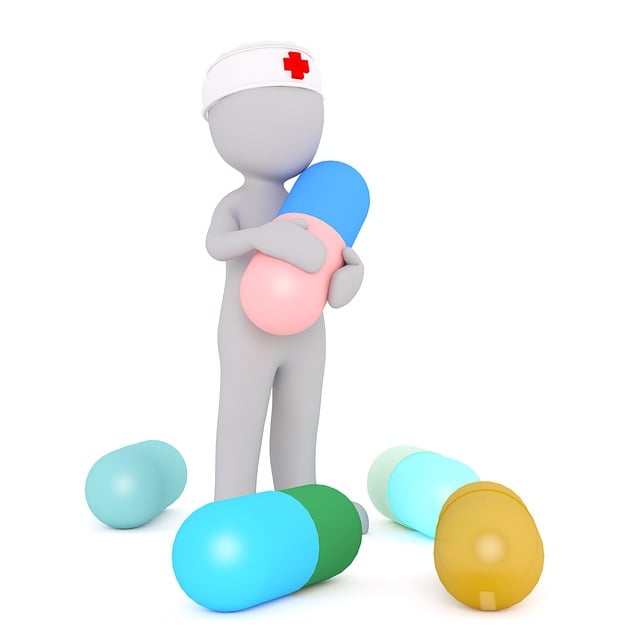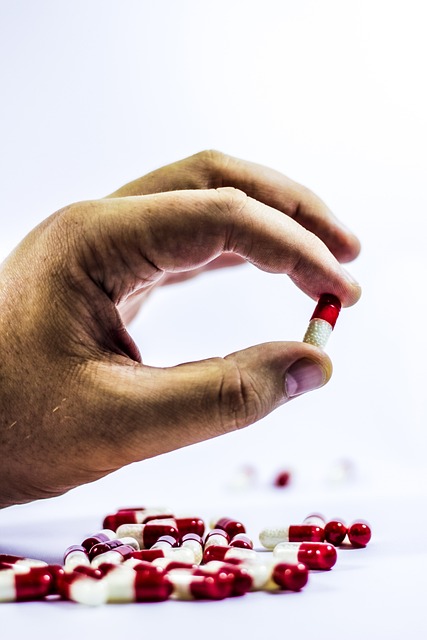GLP-1 receptor agonists (GLP-1 drugs) are a versatile class of medications pivotal in type 2 diabetes management, offering improved insulin secretion and glucagon suppression. They provide a flexible, low-risk approach to blood sugar control with added weight management benefits. With various dosing options and administration methods, including injectables like exenatide and liraglutide, and oral forms such as semaglutide, these drugs enable personalized treatment tailored to patient needs. Individualized dosing factors include age, weight, and glucose levels, while education on proper administration and lifestyle adjustments aid in managing side effects. Future research aims to enhance convenience with long-acting formulations and novel delivery systems, promising a more accessible and effective GLP-1 therapy for diabetes management.
GLP-1 receptor agonists have emerged as powerful tools in diabetes management, offering improved glycemic control and weight loss benefits. This article provides a comprehensive overview of GLP-1 drugs, covering their mechanism of action, different types, dosing considerations, administration routes, and optimal delivery strategies. We explore patient education, common side effects, individualized dosing, and future advancements in GLP-1 drug administration, empowering healthcare professionals to offer effective and personalized treatments.
Understanding GLP-1 Receptor Agonists: Their Role in Diabetes Management

GLP-1 receptor agonists are a class of drugs that mimic the effects of the gut hormone glucagon-like peptide-1 (GLP-1). These drugs play a significant role in diabetes management, particularly for people with type 2 diabetes. By activating GLP-1 receptors, they stimulate insulin secretion in a glucose-dependent manner, helping to lower blood sugar levels. Additionally, they suppress the release of glucagon, a hormone that raises blood sugar, and slow down gastric emptying, contributing to improved glycemic control.
GLP-1 drugs offer several advantages over traditional insulin therapy. They are administered via injection or, in some cases, by mouth, providing flexibility in dosing and administration. Moreover, these agonists have a low risk of hypoglycemia and can aid in weight management by increasing feelings of satiety and reducing appetite. This multifaceted approach makes GLP-1 receptor agonists a valuable tool in the diabetes treatment arsenal, offering improved blood sugar control and potential benefits for overall metabolic health.
Types of GLP-1 Drugs: A Comprehensive Overview

GLP-1 receptor agonists, also known as GLP-1 drugs, come in various forms designed to mimic or enhance the effects of the natural hormone glucagon-like peptide-1 (GLP-1). These medications play a significant role in managing type 2 diabetes by improving glycemic control. The market offers several types of GLP-1 drugs, each with unique characteristics and administration routes. Among them are injectable GLP-1 analogs, such as exenatide and liraglutide, which mimic the natural peptide and stimulate insulin secretion in a glucose-dependent manner. These drugs are administered via subcutaneous injection once or twice daily.
In addition to injections, oral GLP-1 receptor agonists like semaglutide have been developed. This class offers a more convenient administration method while maintaining similar glycemic benefits. The diverse range of GLP-1 drugs allows healthcare professionals to tailor treatments based on patient needs and preferences, contributing to improved diabetes management and quality of life for those affected by this chronic condition.
Dosing Considerations: Factors Influencing GLP-1 Drug Dosage

When considering the dosing of GLP-1 receptor agonists, several factors come into play. These drugs are primarily used for type 2 diabetes management and weight reduction, making their dosage regimens tailored to individual patient needs. The most common GLP-1 drugs are administered once or twice daily, with dosages ranging from 0.3 mg to 2.4 mg, depending on the specific medication and the patient’s response.
Several variables influence the choice of dosage. These include the patient’s body weight, blood glucose levels, and overall diabetes control. Patients with higher blood sugar levels or those who are overweight may require higher doses for optimal efficacy. Additionally, age can be a factor; older patients might need adjustments to avoid adverse effects. Regular monitoring is crucial to determine the most appropriate dosage, ensuring the best results while minimising potential side effects associated with GLP-1 drugs.
Administration Routes: Injectable vs. Oral GLP-1 Therapies

The administration route plays a significant role in determining the effectiveness and convenience of GLP-1 receptor agonists (GLP-1 drugs). While injectable forms have been the traditional method, offering precise dosing control, oral delivery has emerged as a preferred alternative. Oral GLP-1 therapies provide a more patient-friendly approach by eliminating the need for frequent injections. This shift is particularly significant in improving adherence to treatment regimens, especially for patients with type 2 diabetes who may struggle with regular injections.
Oral GLP-1 drugs are typically in the form of tablets or capsules, allowing for once or twice daily dosing. This convenience significantly enhances patient compliance and quality of life compared to injectable counterparts. However, it’s important to note that oral administration may result in varying degrees of metabolic processing, potentially influencing drug absorption and overall efficacy. As such, continuous research aims to optimize oral delivery methods while ensuring the therapeutic benefits associated with GLP-1 receptor activation.
Optimizing GLP-1 Drug Delivery: Frequency and Timing

Optimizing GLP-1 drug delivery involves careful consideration of frequency and timing to ensure maximum efficacy and patient compliance. The typical administration route for GLP-1 receptor agonists is via subcutaneous injection, offering a more convenient alternative to frequent intravenous infusions. Dosing frequencies can vary widely among different GLP-1 drugs, ranging from once daily to multiple times per day, depending on the specific medication’s pharmacokinetics and patient needs.
Timing plays a crucial role in GLP-1 drug delivery. These medications are designed to mimic the natural incretin hormones, which are secreted post-meal. Therefore, administration at consistent times relative to meals can enhance their effectiveness in regulating blood glucose levels. Healthcare providers should educate patients on the importance of adhering to prescribed dosing schedules and timing to optimize GLP-1 drugs’ performance in type 2 diabetes management.
Patient Education: Important Instructions for Taking GLP-1 Drugs

GLP-1 drugs require proper administration and patient education for optimal effectiveness and safety. Patients should be instructed to take these medications exactly as prescribed, typically by injection under the skin once or twice daily. It’s crucial to understand that GLP-1 drugs promote weight loss through various mechanisms, but they do not replace a healthy diet and regular exercise.
Patient compliance is enhanced when they receive clear instructions on preparation, administration technique, and storage of the injections. They should also be made aware of potential side effects, such as nausea or diarrhea, and encouraged to report any unusual symptoms promptly. Regular monitoring by healthcare providers is essential to adjust dosages as needed and ensure the treatment stays aligned with individual patient needs.
Common Side Effects and Management of GLP-1 Receptor Agonist Therapy

GLP-1 receptor agonist therapy, while highly effective in managing blood sugar levels, is not without its side effects. Common experiences include nausea, vomiting, diarrhea, and abdominal pain. These symptoms often arise due to the drug’s similarity to gut hormones, leading to gastrointestinal disturbances. However, they usually subside as the body adjusts over several weeks of treatment.
Managing these side effects involves gradual dosing to minimize discomfort, ensuring adequate hydration, and potentially adjusting meal timings or composition. In most cases, patients can effectively manage GLP-1 drugs’ adverse reactions with simple lifestyle adjustments. If symptoms persist or are severe, healthcare providers may tweak the dosage or explore alternative treatments, emphasizing patient comfort and safety during this therapeutic journey.
Individualized Dosing: Personalizing GLP-1 Treatment Plans

GLP-1 receptor agonists, or GLP-1 drugs, offer a personalized approach to diabetes management. Individualized dosing is a key aspect of optimizing GLP-1 treatment plans. Healthcare providers consider various factors, such as patient age, weight, blood glucose levels, and other medications taken, to determine the most effective and safe dose for each individual. This tailored approach ensures that patients receive optimal benefits while minimizing side effects.
Personalizing dosing allows for a more precise control of blood sugar levels, leading to better glycemic management. It also helps in avoiding potential adverse reactions, which can vary among patients. Regular monitoring and adjustments are crucial to achieve the best possible outcomes, making individualized dosing a cornerstone of effective GLP-1 drug therapy.
Future Perspectives: Advancements in GLP-1 Drug Administration

The future of GLP-1 receptor agonist therapy looks promising with ongoing research focusing on improving administration methods. One area of interest is developing long-acting, once-weekly or even once-monthly formulations, aiming to enhance patient convenience and adherence. These advancements could potentially reduce the number of injections required, making GLP-1 drugs more accessible and user-friendly, especially for patients with diabetes who may struggle with daily injection routines.
Additionally, researchers are exploring novel drug delivery systems such as transdermal patches and oral tablets, offering alternative routes of administration beyond injections. These innovations have the potential to revolutionize GLP-1 therapy by providing a discreet and convenient way of managing blood sugar levels, particularly for those who prefer or require less invasive treatment options.
